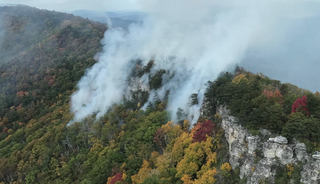 | Back to e-WV
| Back to e-WV
 The West Virginia Encyclopedia
The West Virginia Encyclopedia
 | Back to e-WV
| Back to e-WV
 The West Virginia Encyclopedia
The West Virginia Encyclopedia

Forest fires are among West Virginia’s major environmental problems, damaging thousands of acres of timber each year and causing soil erosion and air and water pollution. There are disproportionately more fires in the southern coalfields, the counties south of the Kanawha River and west of the Bluestone. Absentee land ownership is highest in that region, and arson is a more frequent cause of forest fires there than in other parts of the state.
In addition to arson or incendiary fires, forest fires also start from a variety of accidental causes, including debris burning, campfires, railroads, equipment use, and fallen power lines. Fires in a miscellaneous category may start from hunters illegally attempting to smoke game from den trees, from burning underground coal seams, and from other causes. Lightning, a common cause of fire in western states, starts very few of West Virginia’s forest fires.
West Virginia has statutory fire seasons in the spring (March, April, and May) and fall (October, November, and December). These are the periods when fires are most likely to occur. With the leaves off the trees, the sun rapidly dries the forest floor, creating conditions that make it easy for fires to start. During the two fire seasons, outdoor burning is permitted only from 4:00 p.m. to 7:00 a.m.
West Virginia works with the federal government and private land owners in its fire program. Congress passed the Weeks Act in 1911, authorizing the federal government to purchase forestlands and to cooperate with the states in forest fire prevention. West Virginia appropriated fire protection funds in 1913 and contracted with the federal government to acquire additional funds for the purpose. Subsequent federal and state legislation in the 1910s and 1920s expanded forest fire protection efforts.
The West Virginia Game, Fish and Forestry Commission began an aggressive fire prevention campaign, putting together a traveling show to preach the gospel of forest protection. This consisted of a Model-A Ford truck equipped with a power plant and a portable screen, lantern slides, motion pictures, and projectors. There were also living accommodations including a tent. Emory N. ‘‘Pop’’ Wriston and a helper operated this rig for three years. They would set up on the courthouse lawn or some other central point and present programs to groups of all ages on forest protection, conservation, and forest fire prevention. Smokey Bear was introduced in 1944 by the Wartime Advertising Council and remains one of the nation’s best-known advertising symbols to this day.
In recent times, about 1,100 forest fires burned an average of 38,000 acres annually in West Virginia. In a few exceptional years more than 100,000 acres burned. The dry years of 1987 and 1991 were especially bad, when 429,000 acres and 346,000 acres burned, respectively. After the establishment of organized forest protection the worst year was 1952, when 586,000 acres of forestland burned during the fall fire season and a total 638,000 acres during the year as a whole.
Although just as damaging in the long run, West Virginia’s forest fires normally do not approach the intensity of those in the West. Our fires are mostly surface fires, burning forest litter and small trees and bushes while leaving larger trees standing. They ‘‘crown,’’ or reach the tops of mature trees, only during extremely severe fire weather. Such hot fires kill large trees outright. More often, West Virginia forest fires scorch the bark at the base of the tree, which may later fall off. Insects and diseases may then enter the tree, killing it or making it hollow and worthless for timber. Forest fires also kill wildlife; destroy habitat; and contribute to stream sedimentation, flooding and air pollution.
Written by Robert Beanblossom